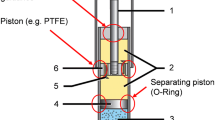Abstract
Space launchers are submitted to complex vibration environments and this can impact the payload it is carrying. Ensuring the protection of the payload therefore requires the addition of a secondary system. In this paper, a rapid design method for the dimensioning of a friction damper is developed, based on the equivalent energy dissipation with that of a viscous damper. A friction damper is designed and a prototype is built. The friction damper is first characterised alone and it is then mounted inside a scale model of a launcher last stage. The friction damper is adequately modelled by a spring in series with a friction element. The damper prototype proves to efficiently damp the rocket engine vibrations, and the design method used for dimensioning the friction damper gives a good approximation for the optimal sliding force of the damper.
Similar content being viewed by others
Abbreviations
- W c :
-
Dissipated energy per cycle in the viscous damper
- W f :
-
Dissipated energy per cycle in the friction damper
- k f :
-
Stiffness of the friction damper
- F g :
-
Sliding force of the friction damper
- p :
-
Pressure in the hydraulic jack of the friction damper prototype
- f :
-
Excitation frequency
- u 0 :
-
Excitation amplitude
- F(t):
-
Temporal signal of the tangential force in the friction damper
- u(t):
-
Temporal signal of the relative displacement across the friction damper
- T :
-
Period of the temporal signals (inverse of f)
- A :
-
Area of the force–displacement (F–u) curve
- A + :
-
Area of the force–displacement curve above F = 0
- A−:
-
Area of the force–displacement curve below F = 0
- F n :
-
Normal force in the friction damper
- F gp :
-
Positive sliding force of the friction damper
- F gn :
-
Negative sliding force of the friction damper
- μ :
-
Friction coefficient of the brake lining
- A trap :
-
Area of the absolute value of the force signal F(t)
- τ :
-
Ratio of sliding time to oscillation period of the friction damper
References
Al Sayed, B., Chatelet, E., Baguet, S., Jacquet-Richardet, G.: Dissipated energy and boundary condition effects associated to dry friction on the dynamics of vibrating structures. Mech. Mach. Theory 46(4), 479–491. (2011). doi:10.1016/j.mechmachtheory.2010.11.014. url:http://www.sciencedirect.com/science/article/pii/S0094114X10002119
Brizard, D., Besset, S., Jézéquel, L., Troclet, B.: Determinantal method for locally modified structures. application to the vibration damping of a space launcher. Comput. Mech. 1–14 (2012). doi:10.1007/s00466-012-0695-9. url:http://www.springerlink.com.gate6.inist.fr/content/5k41075228kr6x44/abstract/
Courtney-Pratt, J.S., Eisner, E.: The effect of a tangential force on the contact of metallic bodies. Proc. R. Soc. Lond. Ser. A Math. Phys. Sci. 238(1215), 529–550 (1957). doi:10.1098/rspa.1957.0016. url:http://rspa.royalsocietypublishing.org/content/238/1215/529
Golafshani, A., Gholizad, A.: Friction damper for vibration control in offshore steel jacket platforms. J. Constr. Steel Res. 65(1), 180–187 (2009). doi:10.1016/j.jcsr.2008.07.008. url:http://www.sciencedirect.com/science/article/pii/S0143974X08001727
Guglielmino, E., Edge, K.A.: A controlled friction damper for vehicle applications. Control Eng. Pract. 12(4), 431–443 (2004). doi:10.1016/S0967-0661(03)00119-9. url:http://www.sciencedirect.com/science/article/pii/S0967066103001199
Guglielmino, E., Sireteanu, T., Stammers, C.W., Gheorghe, G., Giuclea, M.: Friction dampers. In: Semi-active Suspension Control, pp. 99–163. Springer, London. http://www.springerlink.com.gate6.inist.fr/content/l66g38305h3u5640/abstract/ (2008)
Hinrichs, N., Oestreich, M., Popp, K.: On the modelling of friction oscillators. J. Sound Vib. 216(3), 435–459 (1998). doi:10.1006/jsvi.1998.1736. url:http://www.sciencedirect.com/science/article/pii/S0022460X98917369
Ibrahim, R.A.: Friction-induced vibration, chatter, squeal, and chaos—part I: mechanics of contact and friction. Appl. Mech. Rev. 47(7), 209 (1994). doi:10.1115/1.3111079. url:http://link.aip.org/link/AMREAD/v47/i7/p209/s1&Agg=doi
Ibrahim, R.A.: Friction-induced vibration, chatter, squeal, and chaos—part II: dynamics and modeling. App. Mech. Rev. 47(7), 227 (1994). doi:10.1115/1.3111080. url:http://link.aip.org/link/AMREAD/v47/i7/p227/s1&Agg=doi
Kim, J., Choi, H., Min, K.: Use of rotational friction dampers to enhance seismic and progressive collapse resisting capacity of structures. Struct. Des. Tall Special Build. 20(4), 515–537 (2011). doi:10.1002/tal.563. url:http://onlinelibrary.wiley.com/doi/10.1002/tal.563/abstract;jsessionid=43B58DC92AC3F26D69FC6A603215E8A8.d02t02
Laxalde D., Thouverez, F., Sinou, J., Lombard, J.: Qualitative analysis of forced response of blisks with friction ring dampers. Eur. J. Mech. A Solids 26(4), 676–687 (2007). doi:10.1016/j.euromechsol.2006.10.002. url:http://www.sciencedirect.com/science/article/pii/S0997753806001136
Mirtaheri, M., Zandi, A.P., Samadi, S.S., Samani, H.R.: Numerical and experimental study of hysteretic behavior of cylindrical friction dampers. Eng. Struct. 33(12), 3647–3656 (2011). doi:10.1016/j.engstruct.2011.07.029. url:http://www.sciencedirect.com/science/article/pii/S0141029611003130
Mualla, I.H., Belev, B.: Performance of steel frames with a new friction damper device under earthquake excitation. Eng. Struct. 24(3), 365–371 (2002). doi:10.1016/S0141-0296(01)00102-X. url:http://www.sciencedirect.com/science/article/pii/S014102960100102X
Rittweger, A., Albus, J., Hornung, E., Öry, H., Mourey, P.: Passive damping devices for aerospace structures. Acta Astronautica 50(10), 597–608 (2002). doi:10.1016/S0094-5765(01)00220-X. url:http://www.sciencedirect.com/science/article/B6V1N-44TV6SP-3/2/e3b00ba0563b085408c247a18a965c43
Romeuf, T., Le~Gallo, V.: ARIANE 5 New Upper Composite Including a Non Linear Damper. Prediction of the Dynamic Behaviour During On-ground Tests and Flights. EUCASS conference, Moscow (2005)
Author information
Authors and Affiliations
Corresponding author
Rights and permissions
About this article
Cite this article
Brizard, D., Besset, S., Jézéquel, L. et al. Design and test of a friction damper to reduce engine vibrations on a space launcher. Arch Appl Mech 83, 799–815 (2013). https://doi.org/10.1007/s00419-012-0718-1
Received:
Accepted:
Published:
Issue Date:
DOI: https://doi.org/10.1007/s00419-012-0718-1




